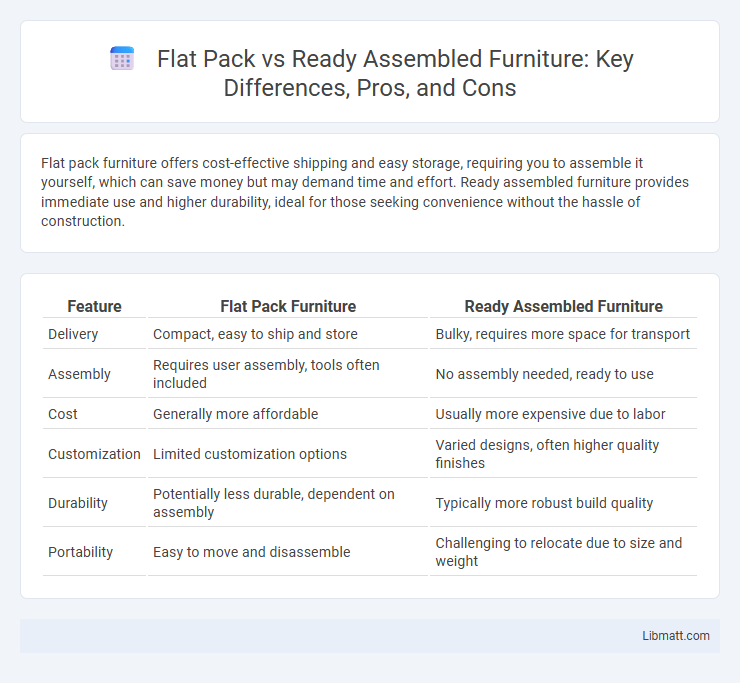Flat pack furniture offers cost-effective shipping and easy storage, requiring you to assemble it yourself, which can save money but may demand time and effort. Ready assembled furniture provides immediate use and higher durability, ideal for those seeking convenience without the hassle of construction.
Table of Comparison
| Feature | Flat Pack Furniture | Ready Assembled Furniture |
|---|---|---|
| Delivery | Compact, easy to ship and store | Bulky, requires more space for transport |
| Assembly | Requires user assembly, tools often included | No assembly needed, ready to use |
| Cost | Generally more affordable | Usually more expensive due to labor |
| Customization | Limited customization options | Varied designs, often higher quality finishes |
| Durability | Potentially less durable, dependent on assembly | Typically more robust build quality |
| Portability | Easy to move and disassemble | Challenging to relocate due to size and weight |
Overview: Flat Pack vs Ready Assembled Furniture
Flat pack furniture offers cost-effective shipping and space-saving storage with components requiring self-assembly using included instructions and tools. Ready assembled furniture arrives fully constructed, providing immediate usability and often higher structural integrity without the need for additional labor. Your choice depends on preferences for convenience versus customization and budget considerations.
Cost Comparison: Which Is More Affordable?
Flat pack furniture generally offers lower upfront costs due to reduced manufacturing and shipping expenses, making it a budget-friendly option for many consumers. Ready assembled furniture typically commands a higher price because of the labor involved in pre-assembly and the increased transportation costs from larger packaging. However, flat pack savings can be offset by potential assembly time and the need for tools, whereas ready assembled products save time and effort, which may justify the premium price for some buyers.
Assembly Time and Convenience
Flat pack furniture requires a longer assembly time, typically ranging from 30 minutes to several hours depending on complexity, but offers the convenience of easy transport and space-saving packaging. Ready assembled furniture eliminates assembly time entirely, providing instant usability, which is ideal for those with limited time or lacking DIY skills. Choosing between flat pack and ready assembled hinges on balancing the desire for convenience against time investment and transportation considerations.
Durability and Quality Considerations
Flat pack furniture often uses engineered wood and requires careful assembly, which can affect its durability and structural integrity depending on user expertise. Ready assembled furniture typically boasts higher quality materials and professional construction, resulting in superior strength and longer lifespan. Evaluating manufacturers' reputation and material specifications is essential to determine the durability of either option.
Style and Customization Options
Flat pack furniture offers extensive customization options, allowing buyers to choose specific finishes, colors, and hardware to match their personal style and room decor. Ready assembled furniture typically provides fewer style variations as it comes pre-built with fixed designs, limiting customization flexibility. Consumers seeking tailored aesthetics often prefer flat pack solutions for their adaptability in creating unique, personalized living spaces.
Delivery and Transportation Factors
Flat pack furniture offers significant advantages in delivery and transportation due to its compact, lightweight packaging that reduces shipping costs and allows for easier handling in tight spaces. Ready assembled furniture, however, often requires larger vehicles and more careful coordination to prevent damage during transit, potentially leading to higher delivery fees and logistical challenges. When choosing between the two, consider your storage capacity and access points to determine which option aligns best with your transportation needs.
Space Efficiency and Storage
Flat pack furniture maximizes space efficiency during transport and storage by disassembling components into compact, flat pieces that fit easily in small spaces or vehicles. Ready assembled furniture requires more storage space due to its fixed dimensions and bulkier form, making it less practical for tight living areas. Flat pack designs also allow for customizable storage solutions, enhancing overall space optimization in homes.
Environmental Impact and Sustainability
Flat pack furniture significantly reduces environmental impact through optimized packaging and lower transportation emissions, as items are packed flat and take up less space during shipping. Ready assembled furniture often requires larger packaging and bulkier transport, leading to higher carbon footprints and increased waste. Choosing flat pack options supports sustainability by minimizing resource use and encouraging efficient supply chain practices.
Ideal Uses for Flat Pack Furniture
Flat pack furniture is ideal for users who need cost-effective, space-saving solutions that simplify transportation and storage. It suits small apartments, temporary living spaces, and individuals who enjoy DIY assembly or frequently move between locations. This type of furniture offers flexibility and customization options for your personal or professional environment.
Best Situations for Ready Assembled Pieces
Ready assembled furniture is ideal for situations where immediate use and time savings are crucial, such as furnishing a new home quickly or upgrading office spaces under tight deadlines. These pieces offer the advantage of durability and higher build quality, making them suited for environments with frequent use or heavy wear. Your choice to invest in ready assembled furniture ensures a hassle-free setup and consistent reliability, especially in professional or high-traffic settings.
Flat pack vs ready assembled Infographic

 libmatt.com
libmatt.com